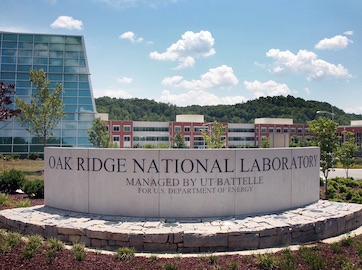Filter Results
Related Organization
- Biological and Environmental Systems Science Directorate (23)
- Computing and Computational Sciences Directorate (35)
- Energy Science and Technology Directorate (217)
- Fusion and Fission Energy and Science Directorate (21)
- Information Technology Services Directorate (2)
- Isotope Science and Enrichment Directorate (6)
- National Security Sciences Directorate (17)
- Neutron Sciences Directorate (11)
- Physical Sciences Directorate
(128)
- User Facilities (27)
Researcher
- Beth L Armstrong
- Gabriel Veith
- Guang Yang
- Lawrence {Larry} M Anovitz
- Michelle Lehmann
- Tomonori Saito
- Yong Chae Lim
- Anees Alnajjar
- Ethan Self
- Jaswinder Sharma
- Rangasayee Kannan
- Robert Sacci
- Sergiy Kalnaus
- Adam Stevens
- Alexey Serov
- Amanda Musgrove
- Amit K Naskar
- Andrew G Stack
- Anisur Rahman
- Anna M Mills
- Brian Post
- Bryan Lim
- Chanho Kim
- Craig A Bridges
- Felipe Polo Garzon
- Georgios Polyzos
- Ilias Belharouak
- Jiheon Jun
- Juliane Weber
- Jun Yang
- Junyan Zhang
- Khryslyn G Araño
- Logan Kearney
- Mariam Kiran
- Matthew S Chambers
- Michael Toomey
- Nageswara Rao
- Nancy Dudney
- Nihal Kanbargi
- Peeyush Nandwana
- Peng Yang
- Priyanshi Agrawal
- Roger G Miller
- Ryan Dehoff
- Sai Krishna Reddy Adapa
- Sarah Graham
- Sheng Dai
- Sudarsanam Babu
- Tomas Grejtak
- Vera Bocharova
- William Peter
- Xiang Lyu
- Yiyu Wang
- Yukinori Yamamoto
- Zhili Feng

This invention utilizes a custom-synthesized vinyl trifluoromethanesulfonimide (VTFSI) salt and an alcohol containing small molecule or polymer for the synthesis of novel single-ion conducting polymer electrolytes for the use in Li-ion and beyond Li-ion batteries, fuel cells,

Here we present a solution for practically demonstrating path-aware routing and visualizing a self-driving network.

CO2 capture by mineral looping, either using calcium or magnesium precursors requires that the materials be calcined after CO2 is captured from the atmosphere. This separates the CO2 for later sequestration and returned the starting material to its original state.

This is a novel approach to enhance the performance and durability of all-solid-state batteries (ASSBs) by focusing on two primary components: the Si anode and the thin electrolyte integration.

Fabrication methods are needed that are easily scalable, will enable facile manufacturing of SSEs that are < 50 µm thick to attain high energy density, and also exhibit good stability at the interface of the anode. Specifically, Wu et al.

We developed and incorporated two innovative mPET/Cu and mPET/Al foils as current collectors in LIBs to enhance cell energy density under XFC conditions.

A new nanostructured bainitic steel with accelerated kinetics for bainite formation at 200 C was designed using a coupled CALPHAD, machine learning, and data mining approach.

Mineral looping is a promising method for direct air capture of CO2. However, reduction of sorbent reactivity after each loop is likely to be significant problems for mineral looping by MgO.

This invention utilizes a salt and an amine containing small molecule or polymer for the synthesis of a bulky anionic salt or containing single-ion conducting polymer electrolyte for the use in Li-ion and beyond Li-ion batteries.

